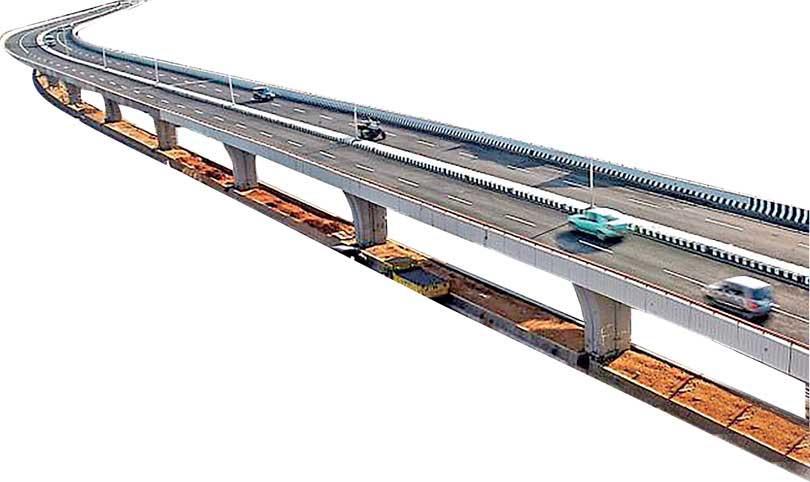Despite an official freeze on costly megaprojects, senior officials from the Highways Ministry are pressuring the Road Development Authority (RDA) to award the proposed US$ 550 million (Rs 110 billion) New Kelani Bridge (NKB) — the elevated highway — to China Harbour Engineering Corporation (CHEC).
Multiple RDA sources confirmed that these officials, who are now holding closed-door discussions with the company, are promoting the project as “a means to attract dollars into the country” in the midst of Sri Lanka’s worst-ever debt crisis.
However, the terms of the financing agreement, according to these sources, are “deeply unfavorable” to the RDA. Due to the debt default, Sri Lanka will be unable to borrow from China Exim Bank or other sources immediately, so CHEC will secure a loan for the project, which will be repaid by the RDA.
The total arrangement, described by RDA sources as a “unusual type of BOT” [build, operate, and transfer] deal, will require the Authority to pay significantly more for the 17km four-lane expressway, which will be supported by pillars the entire distance. In addition, the mandatory environmental impact assessment is incomplete.
Attempts to award the final contract violate at least one court order suspending the process pending the outcome of a judicial challenge to the Rajagiriya to Athurugiriya section on environmental grounds. More than 3 kilometres of this stretch will cross the Thalangama wetland’s Averihena Tank and surrounding paddy fields.
Because of its “ecological, hydrological, and historical importance,” the wetland and its surrounding areas were designated as an Environmental Protection Area (EPA) under the National Environmental Act (NEA) in 2007.
However, in July of last year, the Highways Ministry persuaded Environment Minister Mahinda Amaraweera to amend the gazette to include the construction, operation, and maintenance of the four-lane elevated highway from NKB to Athuruguriya (as well as all construction related to the project) as “permitted uses” under the law.
The project, including this amendment, is being challenged in two different courts. The Centre for Environmental Justice and two Thalangama residents have filed a writ petition with the Supreme Court. This year’s case will be heard again on September 23.
In February of this year, the Appeal Court issued an interim order halting the expressway’s construction until it heard a petition filed by another resident. It was discovered that the project’s EIA had not been obtained. On December 5, the case will be heard.
Despite this, the Highways Ministry intends to present a memorandum to the Cabinet seeking approval to begin procurement for the elevated highway. According to RDA sources, the BOT deviates blatantly from the norm.
BOTs are typically used when a government lacks funds, when long-term concessionary funding from agencies such as the ADB, JICA, and China Exim Bank is unavailable, or when the government’s borrowing limits have been reached.
The developer builds and implements the project in a typical BOT project, usually recouping his investment within 25-30 years. After that, the project is turned over to the government.
If the developer’s revenue falls short of the target during the specified period, the difference between revenue and expenditure is covered by gap funding at the start of the project, or the difference is paid by the government as an annual disbursement.
“Government spending is minimal in both cases,” according to RDA sources. “However, the proposed agreement for this highway by the Highways Ministry is completely different.” It is a distorted BOT scheme that benefits the government.”
“Under the proposed contract, the developer will not be the revenue or toll collector for highway use,” they explained. The developer is responsible for raising project funds. There is no guarantee from the government. As a result, the financial cost will be high,” a source said.
Annuity payments (regular disbursements made every year for a set period of time) for the company’s commercial or concessionary loan.
These payments will be made in the form of annual instalments against the company’s borrowings and will invariably include other terms outlined in the contract agreement.
“The annuity payment is three times the size of a normal loan instalment for the same project,” the source cautioned. “Because CHEC will not receive a sovereign guarantee, it must agree to additional conditions imposed by lenders to cover the additional risks.”
An EPC (engineering, procurement, and construction) contract would be less expensive if a local or foreign contractor was used.
The project is expected to be completed in three years by CHEC. According to the source, the government will then begin making loans for an amount not exceeding 20% of the RDA engineer’s estimate for the highway. However, such borrowings cannot be made until debt restructuring negotiations are completed.
R.W.R. Pemasiri, Secretary of the Highways Ministry, did not respond to written questions, including why the agreement was being pushed through in the midst of a dire economic crisis, what the terms were, and who the lenders were.
CHEC has already received a letter of intent to grant the elevated highway project. However, the Cabinet must approve the next step in the process.
